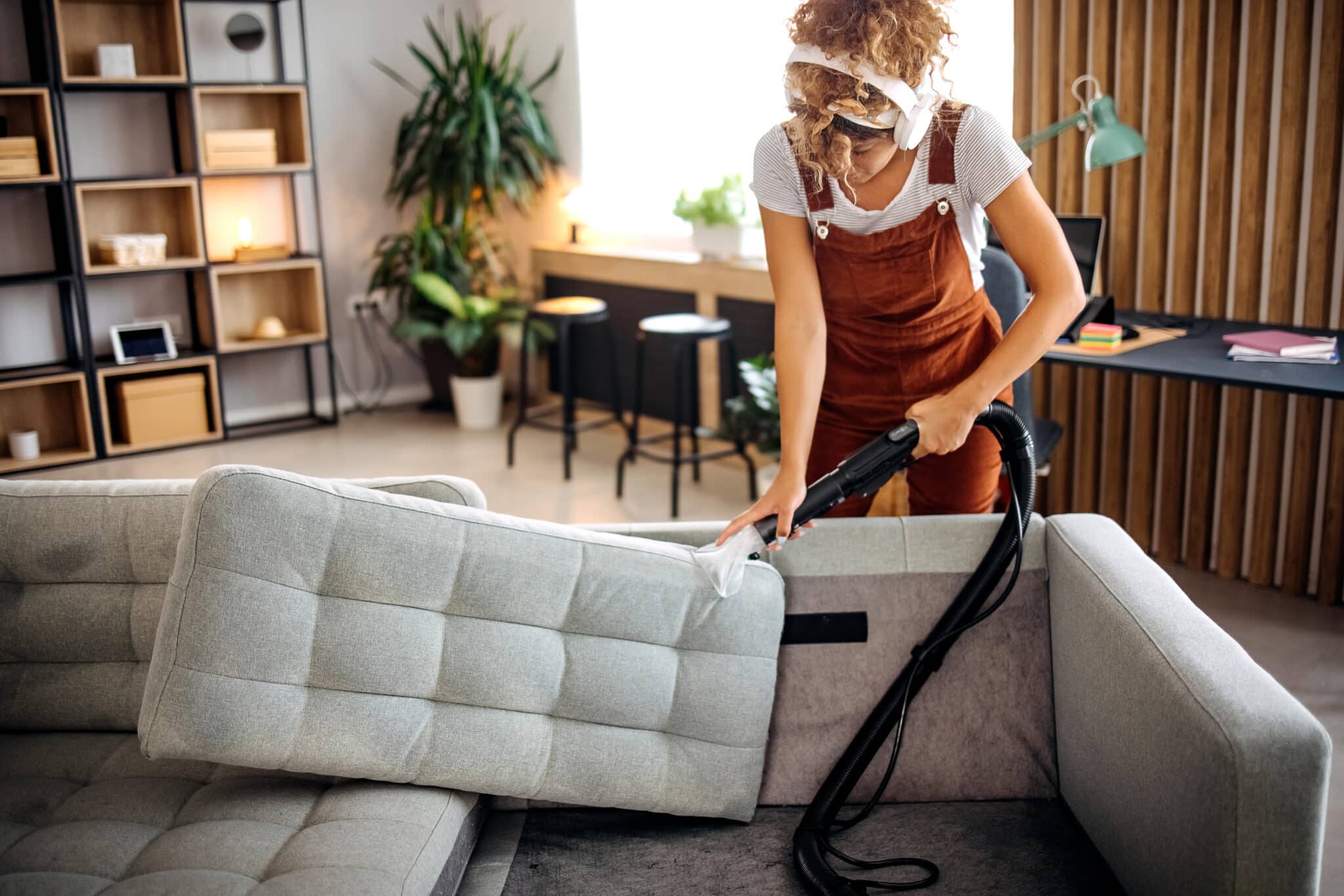Whether you’re dealing with a spill on your upholstery or a mark on your wooden furniture, knowing how to remove a furniture stain effectively will save your pieces from permanent damage.
But what’s the best way to go about removing them?
Here, we’ll show you how to handle some of the most common furniture stains.
Dealing With Upholstery Stains
Even if you don’t have an upholstery cleaning machine, you can still achieve great results.
The first rule for treating an upholstery furniture stain is to blot it with a clean cloth. This is because using rubbing and scrubbing motions, even with a clean dry cloth, can push the stain deeper into the fabric and spread it further.
But don’t fear. Here are some of the best techniques for tackling common upholstery stains to restore your items to their former glory:
Removing a Water-Based Furniture Stain
For stains like coffee, tea, or juice:
- Start by mixing a few drops of dish soap with cold water
- Dab the mixture onto the stain using a cloth, then blot with a dry cloth until the stain is no longer visible
- Repeat if necessary
If the stain persists, you can try using a mixture of white vinegar and distilled water. Simply:
- Blot the stain with white vinegar
- Let it sit for a few minutes
- Rinse with distilled water and blot dry
This approach helps remove any minerals left behind by water that can cause stains to reappear.
Removing an Oil-Based Furniture Stain
For grease or oil stains on upholstery:
- Begin by gently blotting the stain with a paper towel to absorb as much oil as possible without rubbing it deeper into the fabric
- Sprinkle baking soda or cornstarch on the stain and let it sit for 15 to 30 minutes to absorb the oil (both substances are effective at drawing out the grease from the fabric)
- After the powder has had time to work, vacuum it thoroughly to remove the absorbed oil
- Prepare a mixture of a few drops of dish soap with warm water
- Dab the soapy mixture onto the stain with a cloth, gently working it into the fabric, but avoid over-saturating the upholstery
- Rinse the area with a cloth dampened with clean water, and blot dry with a clean towel
Repeat the process if necessary to fully remove the furniture stain.
Removing a Wine & Food Furniture Stain
To tackle wine or food stains on upholstery:
- Begin by blotting the stain with cold water immediately to prevent it from setting
- Use a clean cloth or paper towel to blot up as much of the liquid as possible without rubbing
- Prepare a mixture of water and dish soap
- Apply this soapy mixture to the stain using a cloth, gently dabbing the area to lift the stain
- Blot dry with a clean cloth
- Repeat the process if necessary until the stain is fully removed
For more stubborn stains, a solution of equal parts vinegar and water is very effective. Blot the stain with this vinegar solution, let it sit for a few minutes, and then rinse with cold water. After that, blot the area dry with a clean cloth to remove all remaining moisture.
Removing Stains From Wood Furniture
Before you begin, identify whether your wood furniture has a finish like varnish, shellac, or lacquer; this affects how you should treat the furniture stain.
Different from upholstery, you should gently treat stains on wood furniture with a rubbing or wiping action for the best results.
Here are some of the best ways to treat common wood furniture stains:
Removing a Water Stain From Wood Furniture
To tackle water stains on wood furniture there are two methods you can choose from that both use the heat from an iron:
- Place a clean, dry cloth over the stain
- Press it with a warm iron for a few seconds; this heat method helps evaporate the moisture from the wood and should reduce or remove the stain
Alternately, this second method uses an iron alongside a damp cloth, which may sound counter-intuitive, but could yield great results:
- Dampen a cloth slightly and press it over the stain with the warm iron
- Repeat the process with a dry cloth to absorb any remaining moisture
Removing Isopropyl Alcohol Stains From Wood Furniture
Rubbing alcohol, also known as isopropyl alcohol, can damage wood finishes by dissolving them. So, to handle alcohol stains effectively:
- Quickly wipe the area with a cloth dampened with warm water and mild dish soap
- Dry immediately with a clean, dry cloth to prevent further damage
For lingering stains:
- Mix equal parts white vinegar and olive oil
- Apply the mixture with a soft cloth, and rub gently along the wood grain
- Let it sit for a few minutes
- Wipe away with a clean, damp cloth
For more stubborn stains, consider using a commercial wood cleaner like Murphy’s Oil Soap, and make sure to follow the product instructions carefully for the best results.
Removing an Ink Stain From Wood Furniture
To remove ink stains from wood:
- Start by mixing baking soda and water to create a paste with a texture that’s similar to toothpaste
- Gently rub the paste onto the stain using a soft cloth, taking care not to scratch the wood
- Let the paste sit on the stain for a few minutes to help lift the ink
- Wipe the area clean with a damp cloth to remove any remaining residue
- Repeat the process until the stain is completely gone
For stubborn ink stains, you may need to use a commercial wood cleaner specifically designed for removing tough stains.
Removing Grease & Oil Stains From Wood Furniture
To remove grease or oil stains from wood furniture:
- Start by dampening a clean cloth or cotton ball with mineral spirits—mineral spirits are effective at breaking down and lifting oil from wood surfaces, making it easier to remove stains
- Gently rub the stained area in circular motions, being careful not to saturate the wood too much
- Use a cloth dampened with a mixture of warm water and mild dish soap to clean off any remaining residue
- Quickly dry the area with a clean, dry cloth to prevent any moisture from seeping into the wood
Make sure the wood is completely dry before applying any furniture polish or other treatments.
When To Call in Professional Help
While it’s easy to manage most furniture stains at home, there are times when professional help is the best option.
Here are some scenarios where you may want to call in the experts:
- Stubborn or set-in stains: If a stain persists after multiple cleaning attempts, it may require professional treatment. Professional cleaners use specialized equipment and solutions that can effectively take care of stubborn stains without causing further damage to the fabric or wood.
- Delicate or high-end fabrics: Materials like silk, wool, or antique fabrics require special care. Professional cleaners are trained to handle these materials safely and can prevent further damage that DIY methods may cause.
- Large or extensive stains: For large spills or extensive staining, professional cleaning can ensure a thorough and even clean. This is especially important for items like sectional sofas or large area rugs.
- Odor removal: If a lingering odor from pet urine or other spills accompanies your furniture stain, professional cleaners can use deodorizing treatments to neutralize the smell at its source, rather than just masking it.
By recognizing when a stain is beyond your capabilities, you can avoid lasting damage of your furniture.
How To Keep Your Furniture Stain-Free
The best way to remove a furniture stain is to prevent it from happening in the first place.
Here are a few of the best tips to help keep those stains at bay:
Regular Cleaning
Regular cleaning is one of the most important things you can do to help prevent a furniture stain from setting in.
Dusting and inspecting your furniture regularly, along with using appropriate cleaning products such as upholstery cleaner for fabrics and wood polish for wooden surfaces, will help keep your furniture in top condition.
Protective Measures
In addition to cleaning, using protective measures such as coasters, placemats, and tablecloths will help safeguard your furniture from spills and stains.
For upholstery, using slipcovers or fabric protectors is advisable to prevent accidental spills from causing permanent damage. While throw blankets and pillows on high-use areas will provide added protection and are easy to clean.
Quick Action
Addressing stains promptly is also important. The quicker you react to a spill, the easier it will be to remove the stain.
Keep a cleaning kit handy with basic supplies such as dish soap, baking soda, and vinegar so you can take immediate action—this is the best way to prevent stains from setting in.
Stain-Resistant Sprays
Applying a stain-resistant spray to your upholstery can create a protective barrier that repels liquids and stains, making future cleanups much easier and more effective.
Proper Storage
For outdoor furniture or cushions, storing them in a dry, covered area when not in use will protect them from dust, dirt, and moisture.
By using these preventive measures, you can keep your furniture looking great and extend its lifespan.
Keep Your Furniture Looking Fresh
By following these tips, you can remove almost any furniture stain quickly and easily.
Regular cleaning, quick stain removal, and protective measures will help prevent damage and extend the life of your furniture. Meanwhile, a well-stocked cleaning kit and knowing when to seek a professional will help ensure you can handle almost any furniture stain with confidence.
With consistent care and attention, your space will stay clean and comfortable so you can enjoy your pieces without fear of unsightly stains.





